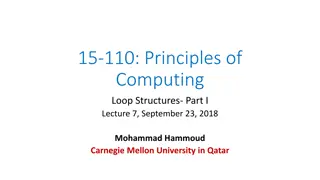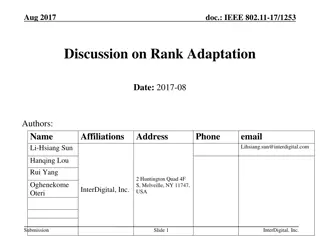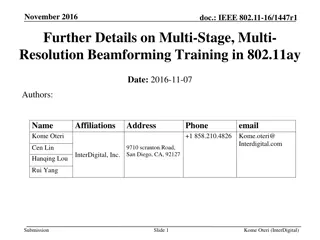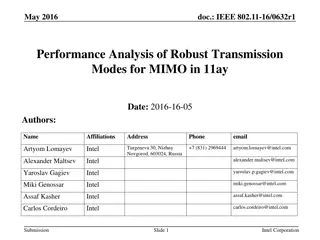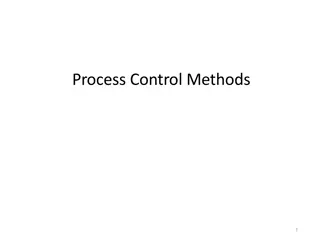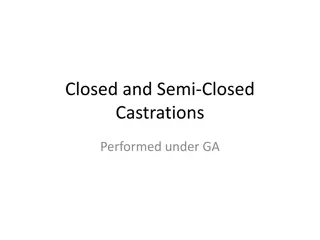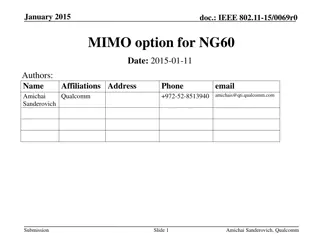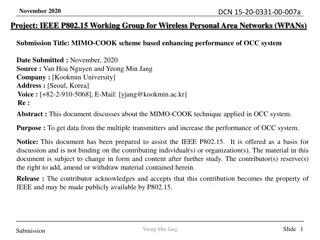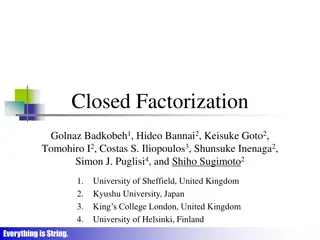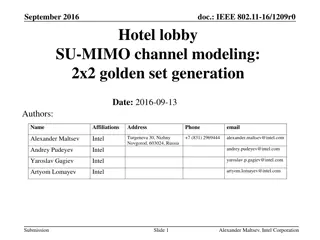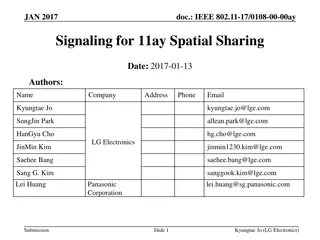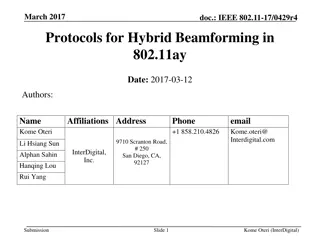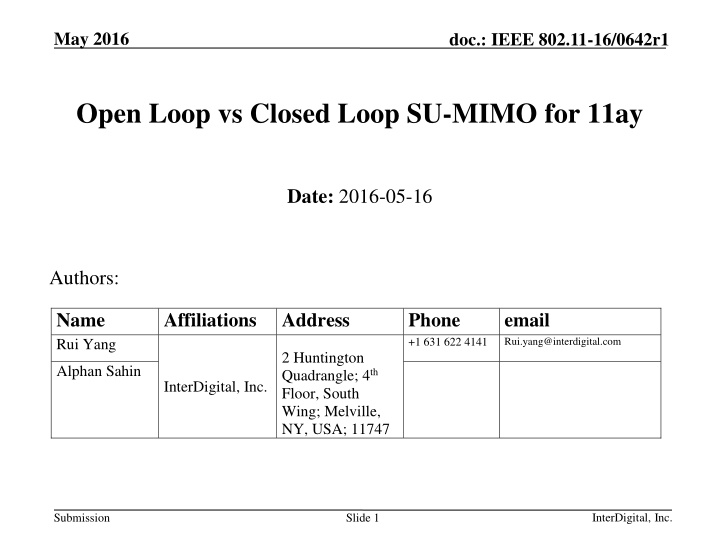
Potential Benefit of Closed Loop SU-MIMO for 11ay Communication
Demonstration of the benefits of closed loop SU-MIMO over open loop SU-MIMO in mmWave communication through system level simulations with different antenna configurations and deployment scenarios. Explore the impact of inter-stream interference and the effectiveness of channel-dependent precoding in improving performance.
Download Presentation

Please find below an Image/Link to download the presentation.
The content on the website is provided AS IS for your information and personal use only. It may not be sold, licensed, or shared on other websites without obtaining consent from the author. If you encounter any issues during the download, it is possible that the publisher has removed the file from their server.
You are allowed to download the files provided on this website for personal or commercial use, subject to the condition that they are used lawfully. All files are the property of their respective owners.
The content on the website is provided AS IS for your information and personal use only. It may not be sold, licensed, or shared on other websites without obtaining consent from the author.
E N D
Presentation Transcript
May 2016 doc.: IEEE 802.11-16/0642r1 Open Loop vs Closed Loop SU-MIMO for 11ay Date: 2016-05-16 Authors: Name Rui Yang Affiliations Address 2 Huntington Quadrangle; 4th Floor, South Wing; Melville, NY, USA; 11747 Phone +1 631 622 4141 email Rui.yang@interdigital.com Alphan Sahin InterDigital, Inc. InterDigital, Inc. Submission Slide 1
May 2016 doc.: IEEE 802.11-16/0642r1 Abstract In this contribution we demonstrate potential benefit from using closed loop (or channel-dependent precoding) SU-MIMO via system level simulations with different antenna configurations and deployment scenarios. InterDigital, Inc. Submission Slide 2
May 2016 doc.: IEEE 802.11-16/0642r1 Background Open loop (OL) SU-MIMO is a viable MIMO scheme for communication in mmW if the analog beam width is very narrow and LoS link is available The performance of open loop SU-MIMO may be degraded by strong inter-stream interference. This may be caused by mutual coupling between the antennas, near field interference, antenna distances, and channel conditions [2]. Questions for a given antenna configuration In which scenario will the inter-stream interference be strong? If closed-loop (CL) SU-MIMO is used, e.g. channel-dependent precoding, can SU-MIMO improve the performance in the presence of strong inter-stream interference? InterDigital, Inc. Submission Slide 3
May 2016 doc.: IEEE 802.11-16/0642r1 Analysis based on Idealized Channel LoS channel model [2] j j e e e 11 12 = H j j e 21 22 ??? are random variables, uniformly distributed between 0 and 2? Receiver: LMMSE CL SU-MIMO is achieved by precoding the Tx signal with the V matrix generated from SVD of the channel matrix (? = ????) Performance metric Achievable sum rate of two streams based on per stream SINR at the output of the LMMSE ?=1 ?[???21 + ??], where ?? is the per-stream SINR at the MMSE output) [5] Observation CL SU-MIMO outperforms OL SU-MIMO when the inter-stream interference is strong. 2 InterDigital, Inc. Submission Slide 4
May 2016 doc.: IEEE 802.11-16/0642r1 Analysis based on 11ad Channel Models Consider antenna configuration #3 [3] Each PAA has 4x4 antenna elements Include Right (R) and Left (L) hand circular polarization cases. Assume the distance (d) between two antennas is 5cm Back lobe beams are assumed blocked Polarization cases Linear Polarization Tx(V, V) Rx(V, V) Tx(V, H) Rx(V, H) Circular Polarization Tx(L, L) Rx(L, L) Tx(L, L) Rx (R, R) The relative orientation of the Tx and Rx is included when generating the channel matrices [4]. Distance between array centers - d PAA element Signal 2nd stream Phase shifter PAA element Signal 1st stream PAA #2 Phase shifter V pol H pol or PAA #1 E E V pol H pol L or R or E E L or R InterDigital, Inc. Submission Slide 5
May 2016 doc.: IEEE 802.11-16/0642r1 Simulation Setup Consider five different models described in [1] Case 1: Cubicle Laptop Far (NLoS only) Case 2: Cubicle Laptop Near (LoS + NLoS) Case 3: Conference Room STA-STA (LoS + NLoS) Case 4: Conference Room STA-AP (LoS + NLoS) Case 5: Living Room (LoS + NLoS) Stations are randomly placed with one degree of freedom in orientation and two degrees of freedom in translation Analog Tx and Rx beams are assumed perfectly aligned in cases with LoS AP Top view of case 3 and 5 Top view of case 1,2 and 4 InterDigital, Inc. Submission Slide 6
May 2016 doc.: IEEE 802.11-16/0642r1 Distribution of Inter-stream Interference Power Measure the distribution of ? = ? measures the orthogonality of the channel matrix Observation: The distribution of p value depends antenna configuration and deployment scenarios ????? (Results with circular polarized antennas are available in Appendix) InterDigital, Inc. Submission Slide 7
May 2016 doc.: IEEE 802.11-16/0642r1 Achievable Sum Rate of LMMSE ? Achievable sum rate = ?=? stream SINR at the MMSE output. Observation: The sum rate gain of CL SU-MIMO over OL SU- MIMO depends on polarization of the antennas, deployment scenarios and SNR ?[????? + ??], where ?? is the per- (Results with circular polarized antennas are available in Appendix) InterDigital, Inc. Submission Slide 8
May 2016 doc.: IEEE 802.11-16/0642r1 Conclusion Although the OL SU-MIMO is an important MIMO mode for 11ay due to its simplicity, its performance may suffer from strong inter-stream interference which depends on many different factors, such as antenna configuration, polarization, environment, accuracy of analog beamforming, etc.. The 11ay system throughput may benefit from CL SU- MIMO, especially when the inter-stream interference is strong. The cost-benefit of using CL SU-MIMO may need to be studied further with consideration of more antenna configurations and usage cases generated in TGay. InterDigital, Inc. Submission Slide 9
May 2016 doc.: IEEE 802.11-16/0642r1 References 1. Alexander Maltsev, et. al., Channel Models for 60 GHz WLAN Systems , 11-09-0334-08-11ad Artyom Lomayev, et. al., Performance Analysis of Open Loop SU-MIMO Receivers for IEEE 802.11ay , IEEE 802.11-16/0388r0 Alexander Maltsev, et. al. Channel models for ieee 802 11ay , IEEE 802.11- 15/1150r3 Rui Yang, et. al. Channel Modeling with PAA Orientations , IEEE 802.11- 16/0339r1 Matthew R. McKay, et. al., Achievable Sum Rate of MIMO MMSE Receivers: A General Analytic Framework , IEEE Transaction on information theory, Vol. 56, No. 1, Jan 2010 2. 3. 4. 5. InterDigital, Inc. Submission Slide 10
May 2016 doc.: IEEE 802.11-16/0642r1 Appendix Inter-stream interference power distribution and CL gain over OL SU-MIMO for Configuration #3 with polarized antennas InterDigital, Inc. Submission Slide 11
May 2016 doc.: IEEE 802.11-16/0642r1 SP (for survey) Do you agree that closed-loop SU-MIMO based on channel-dependent precoding should be considered in 802.11ay? Y: N: A: InterDigital, Inc. Submission Slide 12



